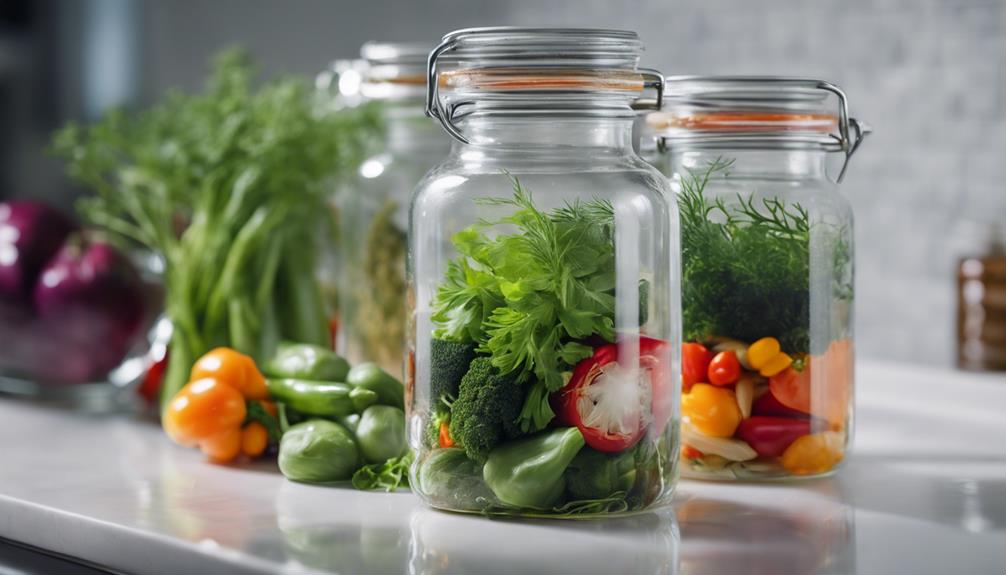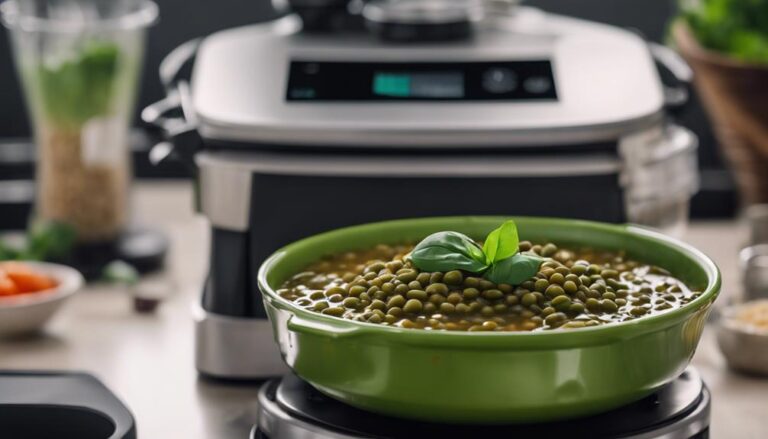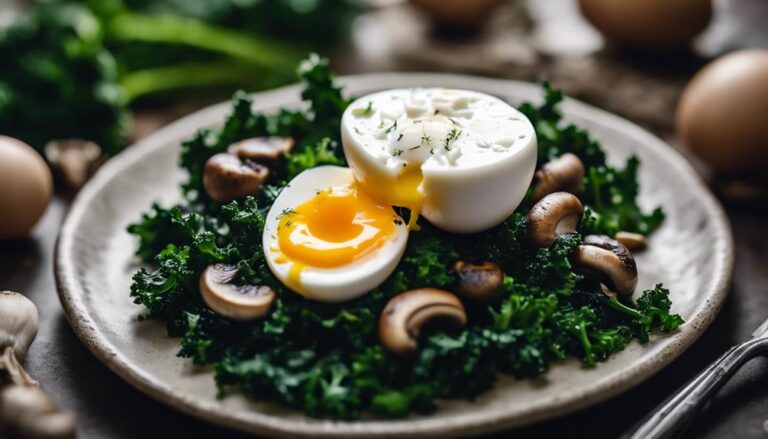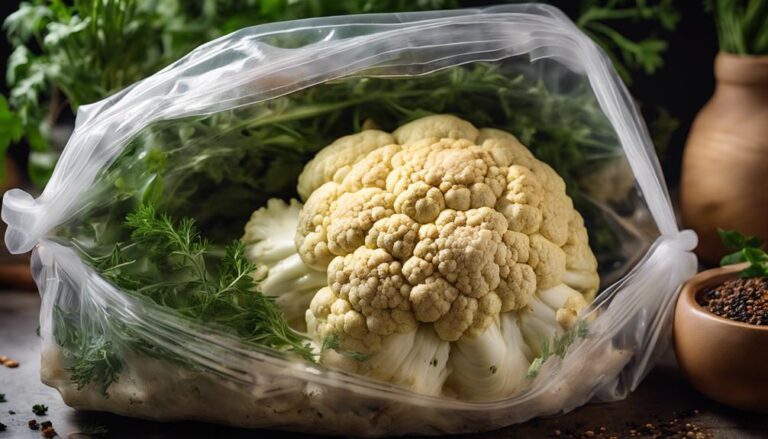Sous Vide Vegetable Broth With Fresh Herbs
Discover a tantalizing blend of flavors in sous vide vegetable broth with fresh herbs. Elevate your cooking with the infusion of aromatic herbs like thyme and rosemary, intensifying the essence of seasonal produce. Enhance your broth's complexity and depth by utilizing the sous vide method for gradual herb infusion, revealing a symphony of tastes. Let the fusion of garden-fresh aromas and vibrant flavors tantalize your palate, promising a culinary journey brimming with richness and sophistication. Uncover how these simple yet potent additions can transform your vegetable broth into a masterpiece of flavors waiting to be savored.
What You Will Learn Here
- Sous vide method enhances herb infusion for rich vegetable broth flavors.
- Fresh herbs like thyme and rosemary provide vibrant, aromatic notes.
- Precise temperature control in sous vide ensures optimal herb extraction.
- Slow cooking in sous vide maximizes herb essence in vegetable broth.
- Fresh herbs added at the end maintain their brightness and freshness.
Broth's Evolution Over Time
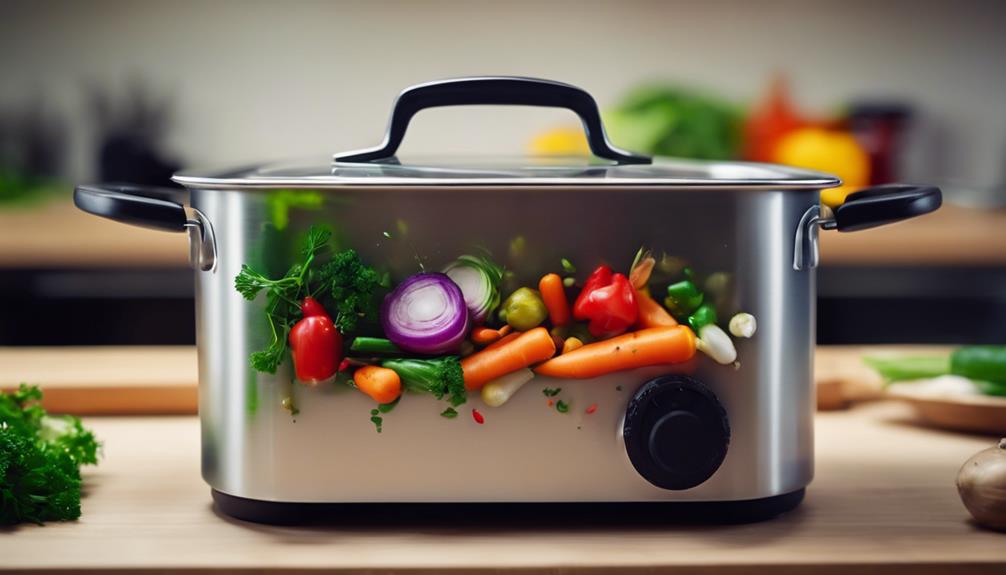
Explore how historical broth recipes have influenced modern variations, shaping the way we use ingredients and flavors in our broths today.
From traditional bone broths to innovative vegetable-based stocks, the evolution of broth reflects changing culinary trends and ingredient preferences over time.
Analyzing these shifts can offer insights into the cultural and gastronomic significance of broth-making practices.
Historical Broth Recipes
Through centuries of culinary exploration and innovation, broth recipes have evolved markedly, reflecting the diverse cultural influences and culinary practices of different regions. Historical culinary techniques played an important role in shaping broth recipes, with each culture adding its unique flavors and ingredients to create distinct variations.
Broth preservation methods were essential in ancient times, with techniques like simmering, salting, or drying used to extend the shelf life of this essential ingredient. Seasonal ingredients also heavily influenced historical broth recipes, as cooks would use whatever vegetables, herbs, and meats were available at the time to create flavorful broths.
As civilizations traded spices and culinary ideas, broth recipes evolved, incorporating new ingredients and techniques that continue to shape modern culinary practices.
Modern Broth Variations
In examining the evolution of broth over time, one can observe a shift towards modern variations that embrace diverse ingredients and innovative cooking techniques. Culinary trends have pushed the boundaries of traditional broth recipes, leading to the incorporation of seasonal herbs and innovative techniques.
Chefs and home cooks alike are experimenting with unique pairings, creating broths that cater to a more adventurous palate. The use of unconventional ingredients such as lemongrass, kombu seaweed, and miso has become increasingly popular in modern broth-making.
Techniques like pressure cooking, smoking, and sous vide have revolutionized the way broths are crafted, resulting in richer flavors and enhanced depth. Embracing these modern variations allows for a broader exploration of flavors and textures in the domain of broth-making.
Changing Ingredient Preferences
As broth-making has evolved over time, there's been a noticeable shift in ingredient preferences, reflecting changing culinary trends and preferences. The rise of plant-based diets and a focus on sustainability has led to a significant increase in the use of seasonal produce in vegetable broths.
Ingredients such as root vegetables, mushrooms, and leafy greens are now favored for their flavor depth and nutritional benefits. Cooking techniques have also played an important role in this evolution, with methods like sous vide enhancing the extraction of flavors from vegetables.
This shift towards plant-based, sustainable ingredients and innovative cooking techniques showcases a growing awareness of health and environmental impact among modern consumers, shaping the way vegetable broths are crafted today.
Vegetable Medley for Broth
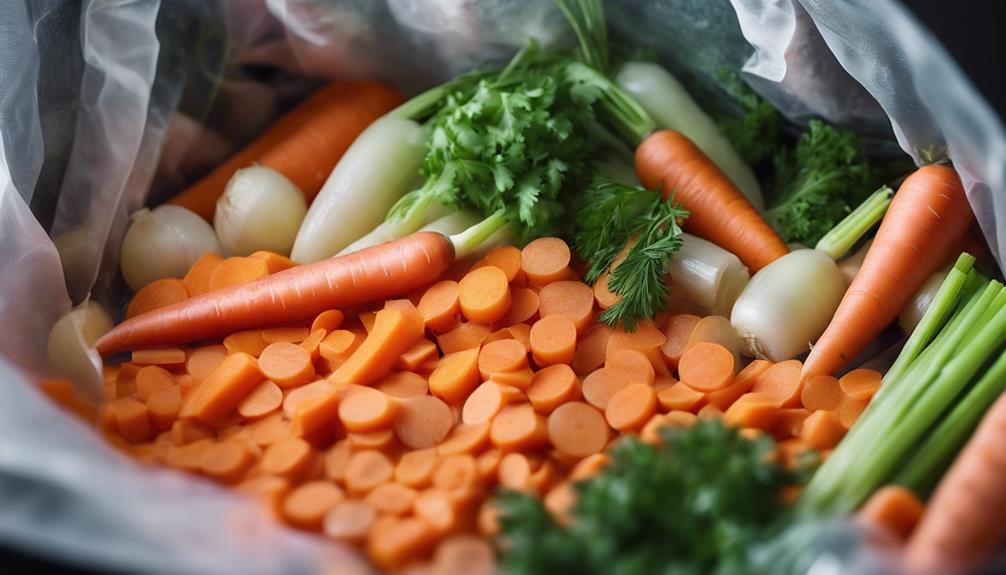
For creating a robust vegetable medley to enhance your broth, contemplate combining a variety of fresh produce to achieve a depth of flavor and nutrients. Seasonal vegetables are essential for maximizing taste and nutritional value in your broth.
Here are three key aspects to contemplate when preparing your vegetable medley:
- Diversity: Incorporating a wide range of seasonal vegetables such as carrots, celery, onions, and leeks can provide a complex flavor profile and a broad spectrum of vitamins and minerals.
- Color: Including colorful vegetables like bell peppers, tomatoes, and beets not only enhances the visual appeal of your broth but also introduces different antioxidants and phytonutrients.
- Aromatics: Adding aromatic herbs like thyme, rosemary, and bay leaves can elevate the overall aroma and taste of your broth, making it more enticing and flavorful.
Top-Rated Vegetable Broth Recipes
Explore the savory Mushroom Broth Recipe, the aromatic Herb-Infused Vegetable Broth, and the comforting Herbed Root Vegetable Broth.
These top-rated vegetable broth recipes offer a variety of flavors and textures to elevate your culinary creations.
Incorporate these recipes into your cooking repertoire for a delicious and nutritious addition to your dishes.
Savory Mushroom Broth Recipe
To elevate your vegetable broth game to the next level, consider trying out a delectable Savory Mushroom Broth Recipe. This rich and flavorful broth adds depth to your dishes and provides a savory umami kick that will impress your taste buds.
Here are three tips to make the most out of this recipe:
- Mushroom Variety: Experiment with different types of mushrooms like shiitake, portobello, or porcini to enhance the complexity of flavors.
- Roasting Technique: Roasting the mushrooms before adding them to the broth can intensify their earthy taste and bring out their natural sweetness.
- Herb Infusion: Adding fresh herbs like thyme, rosemary, or bay leaves can complement the mushroom flavors and elevate the overall aroma of the broth.
Try these tips to create a sumptuous Savory Mushroom Broth that will level up your culinary creations.
Herb-Infused Vegetable Broth
Enhance your vegetable broth with a harmonious blend of fresh herbs for a top-rated culinary experience.
- Herb Selection: Choose a variety of herbs such as thyme, rosemary, and parsley to add layers of flavor to your vegetable broth.
- Infusion Techniques: Experiment with different infusion techniques like simmering the herbs in the broth or using a cheesecloth sachet to contain the herbs while they infuse the liquid.
- Balanced Flavors: Guarantee a balanced infusion by considering the potency of each herb and how they complement the vegetables in your broth.
Herbed Root Vegetable Broth
Utilizing a medley of root vegetables and a selection of aromatic herbs, this herbed vegetable broth recipe elevates traditional broth-making with a robust depth of flavors. Incorporating seasonal produce from your local market guarantees freshness and peak taste.
Building this broth with vegetables like carrots, parsnips, and turnips not only adds earthy notes but also essential nutrients. Raiding your herb garden for fresh rosemary, thyme, and parsley infuses the broth with a burst of herbal essence, enhancing its overall complexity.
The combination of these ingredients creates a rich and hearty broth that serves as a versatile base for various dishes. Experiment with different root vegetables and herbs to customize the flavor profile to your liking, making each batch a unique culinary experience.
Flavorful Herb Pairings
When selecting herb pairings for your vegetable broth, understanding the basics of herb flavors is crucial. Different herbs can enhance the taste of your broth in unique ways, so experimenting with various combinations is key.
Additionally, consider the difference in flavor intensity between fresh and dried herbs when adding them to your sous vide vegetable broth for best results.
Herb Pairings Basics
To create harmonious and flavorful herb pairings, consider the unique characteristics and profiles of each herb to achieve balanced and complementary combinations. Herb infusion involves extracting the essence of herbs into a liquid, enhancing the overall flavor profile.
When exploring flavor combinations, think about the intensity of each herb – some are robust and can overpower, while others are subtle and add depth. For example, pairing the freshness of parsley with the earthiness of thyme can create a well-rounded herb infusion.
Additionally, combining the citrusy notes of lemongrass with the floral hints of lavender can elevate the broth's complexity. Experimenting with different herb pairings can lead to innovative and delicious results in your vegetable broth.
Enhancing Broth Flavors
Enhance the depth and complexity of your vegetable broth by carefully selecting and combining flavorful herb pairings that complement each other harmoniously. When creating your sous vide vegetable broth, consider incorporating flavorful seasonings and aromatic blends to elevate the taste profile. Below is a table suggesting herb pairings that work well together to enhance the overall flavor of your broth:
| Herb Pairing | Flavor Profile | Recommended Usage |
|---|---|---|
| Rosemary & Thyme | Earthy, Woody | Simmering with root vegetables |
| Basil & Parsley | Fresh, Herbaceous | Adding towards the end of cooking |
| Sage & Bay Leaves | Savory, Peppery | Infusing at the beginning of cooking |
| Cilantro & Lemongrass | Citrusy, Bright | Adding towards the end of cooking |
Experiment with these combinations to create a rich and aromatic vegetable broth that will impress your taste buds with its depth of flavors.
Fresh Vs. Dried Herbs
For a more nuanced flavor profile in your vegetable broth, consider the impact of using either fresh or dried herbs in your culinary creations.
Fresh herbs offer vibrant and bright flavors, enhancing the overall taste of your broth. They're ideal for adding a burst of freshness at the end of cooking to preserve their delicate flavors. Culinary uses of fresh herbs like parsley, cilantro, and basil can elevate the complexity of your vegetable broth, providing a garden-fresh essence.
On the other hand, dried herbs are more concentrated in flavor and are suitable for long cooking times, infusing the broth with a robust taste. Experimenting with a combination of fresh and dried herbs can result in a well-balanced and richly flavored vegetable broth.
Final Thoughts
Consider incorporating a variety of herbs for a nuanced flavor profile in your sous vide vegetable broth. Reflecting on the benefits of using fresh herbs, you can experiment with combinations like thyme, rosemary, parsley, and bay leaves to elevate the overall taste of your broth.
Each herb brings its own unique essence, contributing to a more complex and aromatic final product. The sous vide method allows these herbs to infuse gradually, ensuring a full extraction of their flavors into the broth.
Frequently Asked Questions
Can Vegetable Broth Be Made Without Salt for a Low-Sodium Option?
For a low-sodium option, you can make vegetable broth without salt. Enhance flavor with herbs like rosemary and thyme. Consider seasoning substitutes like garlic powder or nutritional yeast. This adjustment caters to dietary restrictions while maintaining nutritional benefits.
Are There Any Alternative Methods to Sous Vide for Making Vegetable Broth?
When making vegetable broth, consider alternative methods beyond sous vide. Pressure cooking and stovetop simmering deliver quick results, while slow cooking in an Instant Pot enhances flavors. Experiment with different techniques to find your preferred method.
How Can Vegetable Broth Be Stored and How Long Does It Last?
To store vegetable broth long-term, freeze it in airtight containers or ice cube trays for easy portions. It can last up to 4-6 months in the freezer. Properly stored, broth maintains quality and flavor, reducing waste.
Can Different Cooking Times Affect the Flavor Intensity of the Broth?
When cooking vegetable broth with various ingredients and techniques, different cooking times affect flavor extraction. Temperature control is essential as longer cooking times may intensify flavors, while shorter times can yield a lighter taste profile. Experiment with ingredient variations for unique results.
What Are Some Creative Ways to Repurpose Leftover Vegetable Broth?
When repurposing leftover vegetable broth, get creative! Use it as a base for savory soups, adding flavorful seasonings. Enhance risottos, stews, or braised dishes. Freeze in ice cube trays for easy flavor boosts in future cooking adventures.
Conclusion
To sum up, utilizing sous vide technology to create vegetable broth with fresh herbs offers a convenient and flavorful alternative to traditional stovetop methods.
By carefully selecting a vegetable medley and pairing it with complementary herbs, home chefs can elevate their dishes with rich, complex flavors.
Experimenting with different combinations can lead to unique and delicious results, making sous vide vegetable broth a must-try for anyone looking to enhance their culinary repertoire.
